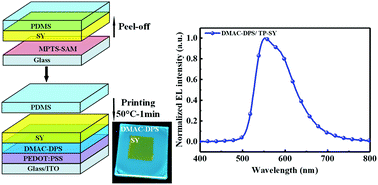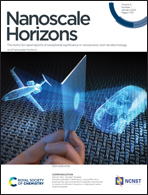Transfer printing of polymer light-emitting devices with a small molecular seeding layer featuring thermally activated delayed fluorescence for triplet harvesting†
Abstract
Transfer printing (TP) technology is capable of fabricating arbitrary thin-films on desired seeding layers or substrates. Here, we employed the TP scheme on a small molecule based hole transporting layer (HTL) as well as a seeding layer to demonstrate a multilayered structure for polymer light-emitting diodes (PLEDs), without the requirement of an orthogonal spin-coating process. To enhance the electroluminescence performance of the fluorescent polymer, poly(para-phenylene vinylene) (Super Yellow, SY), a thermally activated delayed fluorescence (TADF) molecule, 10,10′-(4,4′-sulfonylbis(4,1-phenylene))bis(9,9-dimethyl-9,10-dihydroacridine) (DMAC-DPS), was utilized as the TP seeding layer, which resulted in preferential triplet harvesting and hole transporting, and alleviated exciton quenching, simultaneously. Without the interfacial mixing effect of the small molecular HTL and TP-SY, the state-of-the-art PLED with the fluorescent polymer acquired a considerably high current efficiency of 16.6 cd A−1, which exhibited an almost two-fold enhancement with respect to the standard device with spin-coated SY (8.5 cd A−1). Such TP devices open a new door for developing solution-processed devices with unlimited design of multilayered architectures which are usually restricted by the interfacial mixing effect and the choice of the orthogonal solution.



 Please wait while we load your content...
Please wait while we load your content...